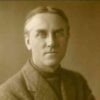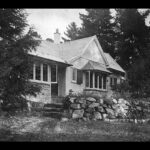Wilhelm Ernst Hans Franz Heysen was born in Hamburg, Germany, on 8th October 1877, the son of Louis Heinrich Wilhelm Heysen and his wife Maria Elisabeth Henriette (née Eberhard). He emigrated to South Australia with his mother and siblings in 1884, his father having come out the year before to seek a better economic future for the family.
His father eventually established himself as a produce merchant, though the family faced great hardships as the state entered a severe depression. Hans was educated at the East Adelaide Model School and four other schools in Adelaide, leaving in 1892 to work in a hardware store and then helping his father on the produce cart. During his childhood he went to stay with a family friend at Hahndorf, thus beginning his life-long attachment to the small German village, the Adelaide hills and, above all, the majestic gum trees.
He attended James Ashton’s Norwood Art School and spent a year at the School of Design at the Art Gallery of South Australia, his fees at the latter being paid by Robert Barr Smith. In 1899 four businessmen financed him for four years in Europe in return for the pictures he painted there. He studied at the prestigious École des Beaux Arts in Paris and also painted in Britain and Europe.
Returning to Adelaide in 1903, he set up a studio and taught art. He married Selma (Sally) Bartels, on 15th December 1904 and they had eight children. Heysen had a very successful one-man show in Melbourne in 1908, after which he gave up teaching and rented a cottage in Hahndorf. There was increasing appreciation from critics and collectors, and a second Melbourne exhibition in 1912 enabled him to buy ‘The Cedars’ at Hahndorf, where he lived and worked for the rest of his life.
Heysen painted many subjects in many mediums, but is best known for his pastoral landscapes, gum trees and still-lifes. He was a water-colourist, etcher and oil-painter, as well as sketching in charcoal and crayon. From 1926 he made many visits to the Flinders Ranges, completing some paintings on site but bringing most back to his studio to be finished. His highly lyrical landscapes, full of brilliant light and vivid colours, were often the first introduction many urban dwellers had to the beauty of the Australian bush. As his biographer Colin Thiele said, ‘The whole nation came to see the gum tree as he saw it.’
Heysen mounted over thirty major exhibitions, won the Wynne Prize for landscape nine times between 1904 and 1932, the Crouch Prize in 1931 and the Maude Vizard-Wholohan Prize in 1957. He was assiduous in assisting young artists and served on the board of the Art Gallery of South Australia. He was awarded the O.B.E. in 1945 and was knighted in 1959. He was also one of the country’s early conservationists, waging a long war against those who wanted to cut down the great gums of the Adelaide hills, and repeatedly warning of the dangers of destroying the natural environment.
Hans Heysen died on 2nd July 1968 and was buried beside his wife at Hahndorf Cemetery. His home ‘The Cedars’ and his studio stand as he left them, preserved by his descendants and open to the public. They contain a representative collection of his life’s work, as does the Art Gallery of South Australia. The Heysen Trail, a walking track stretching 1,500 kilometres from Cape Jervis to Parachilna Gorge in the Flinders Ranges, was named in his honour.






Comments